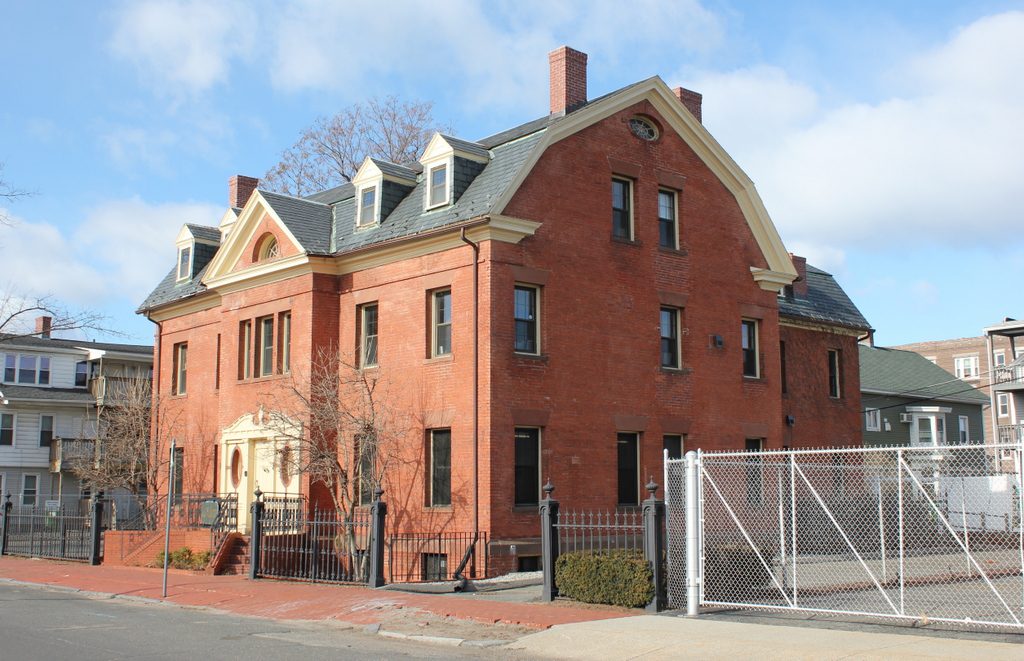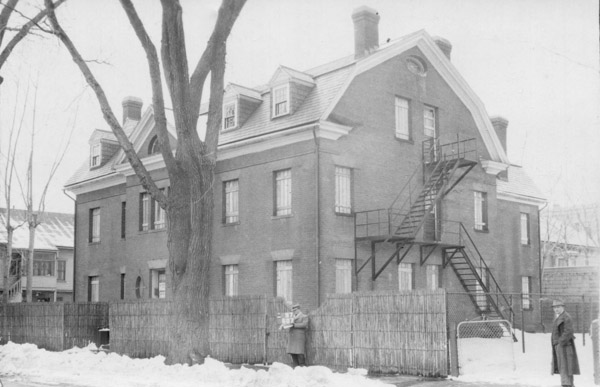The building at 136 William Street in Springfield, around 1938-1939. Image courtesy of the Springfield Preservation Trust.
The building in 2017:

Springfield was experiencing rapid growth in the 1860s. The Civil War had drawn many to work in the Armory and other factories that contributed to the war effort, and the city grew by 45 percent between 1860 and 1865. With an expanding population came more social problems, though, and in 1865 the Home for Friendless Women was established to provide temporary housing and services for needy women and children. Among the founders, and the organization’s first president, was Rachel Merriam, the wife of dictionary publisher Charles Merriam.
The original building was located on Union Street, directly behind the Merriams’ house on Howard Street. Among those who found shelter here were girls and women fleeing physical and sexual abuse, as well as “fallen women,” a Victorian euphemism for prostitutes. Despite its somewhat bleak-sounding name, the Home for Friendless Women provided much-needed services at a time when such assistance from the government was essentially unheard of, and it was the first charity of its type in the region.
By the late 1880s, the old Union Street building had become too small to meet the growing needs of the organization. After Charles Merriam’s death in 1887, Rachel donated her house on Howard Street. This became the new facility for a few years, but there was still a need for a new building, so in 1897 they opened a new building on William Street, which is seen here. Its design reflects the Colonial Revival style, which was coming into popularity at the end of the 19th century, and it was the work of local architects Benjamin R. Bushey and Guy Kirkham.
Over the years, the building provided shelter for women in a variety of situations. Census records during this time give an interesting snapshot of who was living here, and in 1900 there were ten residents, which included four elderly widows, four single girls in their teens or early twenties, and two young children. Ten years later, in 1910, there were 13 residents, most of whom were elderly and/or widowed. There was also a 36 year old single woman and her infant daughter, plus two teenaged girls and, rather curiously, a 13-year-old boy who does not appear to have been related to anyone else at the home. By the 1920s, it became known as the Home for Girls, and focused exclusively on serving unwed mothers and expectant mothers.
This facility was still in use when the first photo was taken in the late 1930s, although overcrowding led the organization to move elsewhere in 1940. By this point, the South End had become largely Italian, and the building became the lodge for the Sons of Italy, an Italian-American fraternal organization. Although they no longer use the building, it is still standing, with few exterior changes, and it is an excellent example of institutional Colonial Revival architecture in the city. As for the Home for Friendless Women, the organization is now known as the Children’s Study Home, and continues to serve Springfield more than 150 years after Rachel Merriam helped to establish it.


I think my mother may have been the infant daughter. She was born in 1910 in July and her name was Florence May Spear. I think my grandfather and grandmother may have adopted her. If you have any information on this would you please send me some info. My name is below. Thank you My grandfathers name was Harley H Vance and he named her Lois Murray Vance (Tarr) And I was named after her.. I am 85 years old. And I would like to see if I am right.
The 36-year-old woman in the 1910 census was Nina Carlson, an immigrant from Sweden. Her daughter, Caroline, was born on April 1, 1910, and the census was taken later that month. It looks like, during the census, your mother’s mother, Flora Spear, was a 17-year-old live-in servant for Horatio and Inez Myrick, who lived at 48 Hopkins Place in Longmeadow. I hope that helps!
Thank you very. It will help me and my nephew who is doing a history for our family.
I am adopted I was born January 1, 1963. My birth certificate says Springfield Massachusetts
I am looking for a male born around 1904 or 1905 in the area and given up for adoption. The mother would have been a teenager. She may have been married at the time but the baby was not her husbands. She immigrated from Russia (Poland) around 1903-1905, and eventually settled in Holyoke by 1910.
Any suggestions would help. Thank you.
I am seeking information on Madeline Hayes who may have been in this house in 1925 and gave birth to a boy, Arthur Philip Benson. The boy was later adopted, and Madeline does show up back in Pennsylvania later in 1925. Is there a way to find more information on her…we know where the boy is. Thank you.
my grandfather, Charles and his brother John and sister Edith Myrtle were housed there in the early 1900s. There is an original ledger housed in the genealogy library in Springfield showing names of the individuals who were there.
Any possibility to know if my mother was there in 1931?
She had just turned 19 and was pregnant, family sent her away because member of prominent family in small town ,Ma. She had a boy but do not know what month. Never knew this until AFTER my mother died . She never shared this info . I was told by a non blood uncle that i had a half brother 14 years older than I. Any way of finding out who he is or was are there may be long lost relatives. I have no other info or anyone anyplace to look for him or his family!
Everyone in family is dead now. Feel I have missed out knowing this brother. Holden is family last name
Myrtle was my mother’s first name.
Help is appreciated!
Judie
I am looking for information about my Great Grandmother, who may have resided here, with her toddler son and infant daughter. Her name was Bertha Mayo (Lawrence) and children were George and Vivian Grace. Bertha’s husband, David G. Mayo died in May 1921 in Worcester, MA and she was forced to move to a home for unwed mothers. Her daughter Vivian died in June 1921 at the age of 3 months, of accidental asphyxiation (suffocated in a pillow, which she was propped on in her crib). During the last few days of her life, my Great Grandmother was “babbling” a lot and some of it was about the aforementioned information.
Looking for info on Thomas Edward forest and his mother Margaret rose forest. She birthed Thomas here on April 30, 1923.